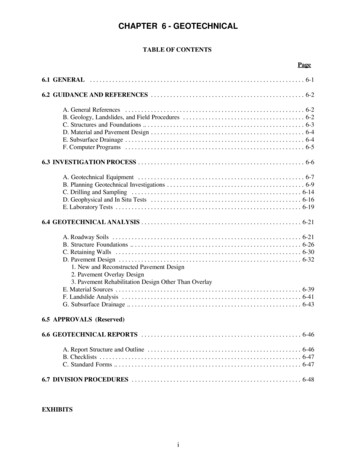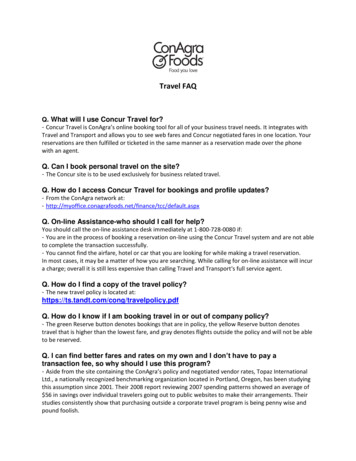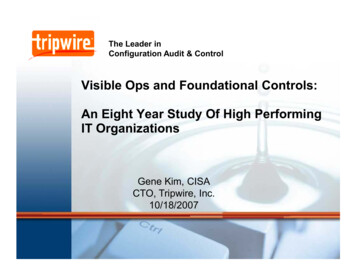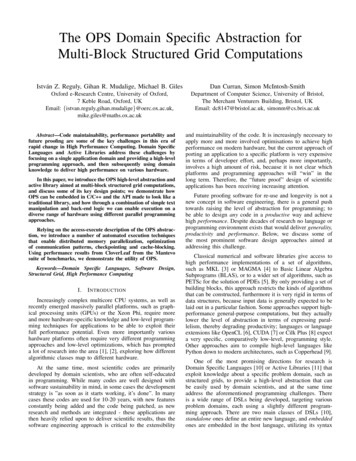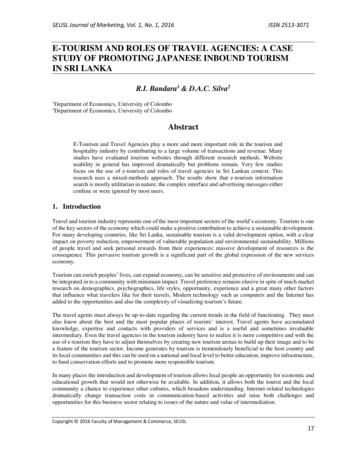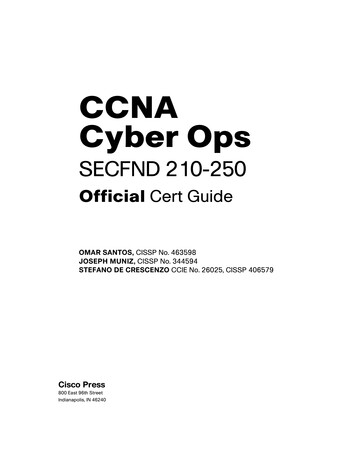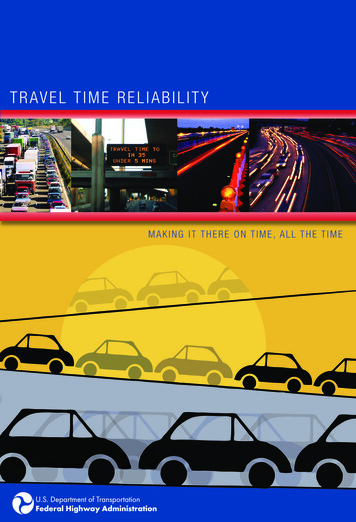
Transcription
TRAVEL TIME RELIABILITYMAKING IT THERE ON TIME, ALL THE TIME
Traffic congestion is a daily reality INmost of the large urban areas in theUnited States.It’s to be expected—large numbers of people all trying to reachtheir destinations at the same time, usually during peak hours.Drivers are used to the everyday congestion and they plan forit. They don’t like it, but they leave home early enough to getto work on time. It’s the unexpected congestion that troublestravelers the most from day today. A trip that usually takesa half-hour, with little or nowarning, takes an hour.Now the motorist is late forwork, has missed a doctor’sappointment, or is facing heftychildcare penalties for picking upthe kids late. Maybe a trucker gets held up in unexpected traffic,making shipments late to the manufacturer, disrupting just-intime delivery, and losing the competitive edge on other shippers.Travelers want travel time reliability—a consistency ordependability in travel times, as measured from day to day oracross different times of day. Drivers want to know that a tripwill take a half-hour today, a half-hour tomorrow, and so on.
Why is travel time reliabilityimportant?Figure 1. Averages don’t tell the full storyHow traffic conditionshave been communicatedTravel TimeMost travelers are less tolerant of unexpected delaysbecause such delays have larger consequences thandrivers face with everyday congestion. Travelersalso tend to remember the few bad days they spentin traffic, rather than an average time for travelthroughout the year (see Figure 1).In order to improve travel time reliability, thefirst step is to measure it. Measures of travel timereliability better represent a commuter’s experiencethan a simple average travel time. For example, atypical before-and-after study attempts to showthe benefits of an incident management program(see Figure 2). Looking at average travel time, theimprovement may seem modest. However, traveltime reliability provides a different perspective ofthe improvement: the worst few days have beendramatically improved. Travelers make it to theirdestinations on time more often or with fewersignificant delays.Annual averageJan.JulyDec.What travelers experience. . .Travel Time. . .and whatthey rememberTravel times varygreatly day-to-dayJan.JulyDec.Figure 2. Reliability measures capture the benefits of trafficmanagementHow do agencies measuretravel time reliability?Small improvement inaverage travel timesTravel TimeTravel time reliability measures are relatively new,but a few have proven effective. Most measurescompare high-delay days to those with an averagedelay. The most effective methods of measuringtravel time reliability are 90th or 95th percentiletravel times, buffer index, and planning time index,explained in the following sections.Average DayBefore2003Several statistical measures, such as standarddeviation and coefficient of variation, have been usedto quantify travel time reliability. However, they arenot easy for a nontechnical audience to understandand would be less-effective communication tools.They also treat early and late arrivals with equalweight. But the public cares much more about latearrivals.After20042005Large improvement intravel time reliabilityTravel TimeWorst Dayof the MonthBefore20032After20042005
90th or 95th percentile travel timesPlanning time indexThis method, the 90th or 95th percentile travel times,is perhaps the simplest method to measure traveltime reliability. It estimates how bad delay will beon specific routes during the heaviest traffic days.The one or two bad days each month mark the95th or 90th percentile, respectively. Users familiarwith the route (such as commuters) can see howbad traffic is during those few bad days and plantheir trips accordingly. This measure is reported inminutes (as shown in Figure 6).The planning time index represents how much totaltime a traveler should allow to ensure on-timearrival. While the buffer index shows the additionaltravel time that is necessary, the planning time indexshows the total travel time that is necessary (seeFigure 3).For example, a planning time index of 1.60 meansthat for a trip that takes 15 minutes in light traffica traveler should budget a total of 24 minutes toensure on-time arrival 95 percent of the time.Free-flow travel time 15 minutesPlanning time index 1.60Planning time 15 minutes 1.60 24 minutesBuffer indexThe buffer index represents the extra time (ortime cushion) that travelers must add to theiraverage travel time when planning trips to ensureon-time arrival.The planning time index is especially useful becauseit can be directly compared to the travel timeindex (a measure of average congestion) on similarnumeric scales. The travel time index is a measure ofaverage conditions that tells one how much longer,on average, travel times are during congestioncompared to during light traffic.For example, a buffer index of 40 percent meansthat for a trip that usually takes 20 minutes a travelershould budget an additional 8 minutes to ensureon-time arrival most of the time.Average travel time 20 minutesBuffer index 40 percentBuffer time 20 minutes 0.40 8 minutesFigure 3 illustrates the relationship between thebuffer index and the planning time index. The bufferindex represents the additional time that is necessary,whereas the planning time index represents the totaltravel time that is necessary.The 8 extra minutes is called the buffer time.Therefore, the traveler should allow 28 minutes forthe trip in order to ensure on-time arrival 95 percentof the time.Figure 3. Reliability measures compared to average congestion measures (Source: http://mobility.tamu.edu/mmp/)2.20Los Angeles, 2003 citywide data shown2.00Planning time indexIndex Value1.80Buffer time betweenexpected (avg.)and 95th percentiletravel times1.601.40Travel time index(average)1.201.0012 AM2 AM4 AM6 AM8 AM10 AM12 PM2 PM4 PMTime of Day (weekdays, non-holidays only)Travel TimePlanning Time36 PM8 PM10 PM12 AM
How does an agency beginusing travel time reliabilitymeasures?Figure 4. A methodical approach can be used to developreliability measuresSTEP 1. Determine how measures will be usedPutting these methods to work requires an overallevaluation and implementation process. Figure 4briefly shows the steps involved in measuring traveltime reliability and how to put that information towork for travelers and traffic managers. Define the structure and content of program Quantify benefits for elected officials and keydecision-makers Monitor conditions for fine-tuning operational procedures Compare alternative multi-modal investment scenariosWho is currently using traveltime reliability measures?STEP 2. Develop a plan based on uses and users Define travel modes, routes, trips, days, times of interestEven though travel time reliability measures arerelatively new, several agencies have already begunusing them. Agencies such as the Federal HighwayAdministration (FHWA), Minnesota Departmentof Transportation (Mn/DOT), and the WashingtonState Department of Transportation (WSDOT)have primarily used travel time reliability as aperformance measure to supplement measures ofaverage congestion. Define data source and calculation procedures Develop communication tools for resultsSTEP 3. Collect and process required data Continuous data collection from IntelligentTransportation Systems (ITS) most desirable Other methods to collect or estimate data are possible Use quality assurance methods Calculate route or trip travel times (basic data element)FHWAFHWA supports a national traffic monitoringprogram that tracks reliability measures in more than30 cities. FHWA communicates this information tokey decision-makers through a monthly dashboardreport (see Figure 5). The report includes trendinformation on the duration (hours of congestedtravel per day), magnitude (travel time index), andreliability (planning time index).STEP 4. Calculate reliability measures 95th or other percentile travel time Buffer index Planning time indexSTEP 5. Communicate measures in meaningfulway Annotated graphics that avoid “tech-speak” Relate to traveler’s experienceFigure 5. A reliability measure is included in FHWA’s Monthly Congestion Dashboard ReportStatus:Progress:NATIONAL CONGESTION INDICATORSGreenGreenCurrent Quarter4.8231.2841.690Same Quarter, Previous Year5.1811.2941.707Change vs. Previous Year6.91%National Congestion PatternTotal Cities: 190.77%1.00% Planning Time Index Travel Time Index Hours of CongestedTravel Per Day# ofCitiesDOWN 5%# ofCities NOCHANGE# ofCitiesUP 5%# ofCitiesDOWN 5%# ofCities NOCHANGE# ofCitiesUP 5%# ofCitiesDOWN 5%# ofCities NOCHANGE# ofCitiesUP 5%946217041324
Mn/DOTIn 2000, Mn/DOT used travel timereliability measures to study the effects ofa ramp meter shutdown on MinneapolisSt. Paul freeways. In this study, Mn/DOTreported that turning off the rampmetering system caused travel timereliability to worsen by 91 percent. Incomparison, the average travel timesworsened by only 22 percent. Thesefindings support the concepts presented inFigure 2—operational improvements havea greater effect on day-to-day travel timereliability than on average travel times.As a result of this legislatively mandatedstudy, Mn/DOT was able to continueoperating its ramp metering programin 2001.Figure 6. WSDOT provides reliability measures for traveler information(Source: s/reliability/)WSDOTWSDOT tracks travel time reliabilityin its performance-monitoring effortsand provides reliability estimates tocommuters. A page on the WSDOTwebsite (see Figure 6) allows commutersto select a trip and generate a 95thpercentile travel time based on historicaldata. Commuters can then use the traveltime estimate to ensure they arrive on time for thatparticular trip.WSDOT also uses reliability measuresin reporting the performance of freewaysand high-occupancy vehicle (HOV) lanesWhere can I find moreinformation?A guide to travel time reliability is availableat http://www.ops.fhwa.dot.gov/. It containssupporting information and technical details ondeveloping travel time reliability measures.Produced by Texas Transportation Institute with Cambridge Systematics, Inc.(http://depts.washington.edu/hov). In particular,WSDOT uses the 90th percentile travel time andthe frequency of congestion performance measuresto determine operating strategies and prioritizeimprovements.Contact InformationFor more information, contact:Rich Taylor, FHWA(202) 0601.0106.2M
Travel time reliability measures are relatively new, but a few have proven effective. Most measures compare high-delay days to those with an average delay. The most effective methods of measuring travel time reliability are 90th or 95th percentile travel times, buffer index, and
